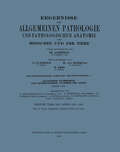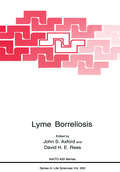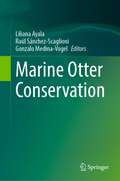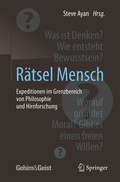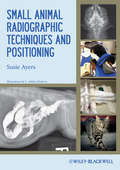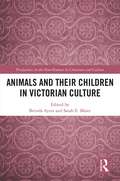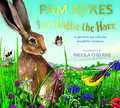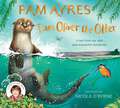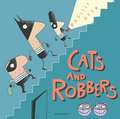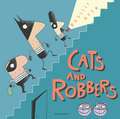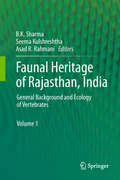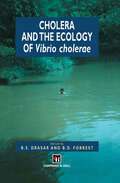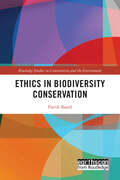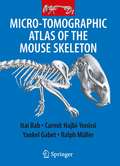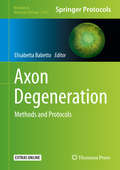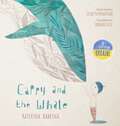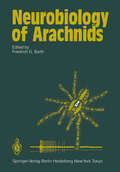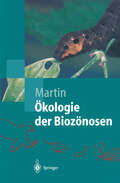- Table View
- List View
Ergebnisse der Allgemeinen Pathologie und Pathologischen Anatomie des Menschen und der Tiere: Einundzwanzigster Jahrgang: Ergänzungsband. I. Allgemeine Pathologie und Pathologische Anatomie des Auges
by Th. Axenfeld Arthur Birch-Hirschfeld W. Hoffmann Heinrich Jakob A. Peters R. Seefelder Paul WätzoldDieser Buchtitel ist Teil des Digitalisierungsprojekts Springer Book Archives mit Publikationen, die seit den Anfängen des Verlags von 1842 erschienen sind. Der Verlag stellt mit diesem Archiv Quellen für die historische wie auch die disziplingeschichtliche Forschung zur Verfügung, die jeweils im historischen Kontext betrachtet werden müssen. Dieser Titel erschien in der Zeit vor 1945 und wird daher in seiner zeittypischen politisch-ideologischen Ausrichtung vom Verlag nicht beworben.
Glycoimmunology 2 (Advances in Experimental Medicine and Biology #435)
by John S. AxfordThe Jenner International Glycoimmunology Meetings have charted the rapid devel opment of glycobiology within the field of inflammation. In less than a decade, the science has grown from basically being involved in carbohydrate analysis to the understanding of how sugars are associated with inflammation and how they have potential as anti inflammatory therapeutics. The 4th Jenner International Glycoimmunology Meeting was re cently held in Loutraki, Greece, and set the scene for what promises to be an exciting future for the speciality. Discussion reflected the rapid advances glycobiology is making and ranged from the basic biochemistry of carbohydrate physiology to therapeutic trials utilizing synthetic sugars designed to block inflammatory responses. The meeting is summarized in considerable detail in this book which will provide the interested scientist and clinician with the essential up-to-date facts within the field of glyco immunology. Acknowledgments Many people have been involved in ensuring the success of the Jenner Glycoimmu nology Meetings but none more so than my secretary Susan Henderson who has borne the brunt of all four meetings and is currently preparing for the 5th.
Lyme Borreliosis (Nato Science Series A: #260)
by John S. Axford David H. E. ReesLyme Borreliosis is a worldwide infectious disease causing a multisystem illness with considerable morbidity, particularly in North America and Europe. The causative agent is the spirochaete Borrelia burgdorferi, which is usually transmitted by the ixodid tick from animal reservoirs. This book is formed by contributions from the Second European Symposium on Lyme Borreliosis, held at St George's Hospital Medical School, London in 1993, which reviewed the current state of knowledge of the condition with regard to clinical manifestations, diagnosis, treatment, ecology, epidemiology, biology and immunopathogenesis. In this book, important data is reviewed concerning the clinical manifestations of Lyme Borreliosis. It seems that strain variation of the spirochaete is the main cause of regional differences seen in the clinical presentation of patients. One striking example of this, is the relatively high incidence of Lyme arthritis in the USA and apparent rarity of this manifestion in some areas of Europe. These important studies open the way for exciting new research that focuses on the immunological and molecular mechanisms that result in disease. A full insight into the ecology of Borrelia burgdorferi is essential to a balanced understanding of the disease and a number of excellent reviews on this subject are included. Significant advances with regard to the biology of Borrelia burgdorjeri and the immunopathogenic mechanisms that result in disease have been made, enabling the role of the Band T lymphocytes in disease to be established and the development of sophisticated phenotyping methods, improved diagnostic tests and effective vaccines.
Cognitive Neuroscience of Memory Consolidation (Studies in Neuroscience, Psychology and Behavioral Economics)
by Nikolai Axmacher Björn RaschThis edited volume provides an overview the state-of-the-art in the field of cognitive neuroscience of memory consolidation. In a number of sections, the editors collect contributions of leading researchers . The topical focus lies on current issues of interest such as memory consolidation including working and long-term memory. In particular, the role of sleep in relation to memory consolidation will be addressed. The target audience primarily comprises research experts in the field of cognitive neuroscience but the book may also be beneficial for graduate students.
Marine Otter Conservation
by Liliana Ayala Raúl Sánchez-Scaglioni Gonzalo Medina-VogelThis book offers a multidisciplinary approach to conservation issues related to the marine otter (Lontra felina). The main goal is the systematization of different research efforts on this species, to contribute with conservation policy design and implementation. The authors contribute their achievements in conservation, ecology, status in freshwater habitats, habitat fragmentation effects, interaction with human activities and recommendations for an effective conservation of the species. The book is directed first and foremost towards researchers and authorities and people involved in conservation tasks of otters.Despite in the last decades some studies and efforts on Lontra felina has carried in Peru and Chile, some information can be gathered to fill the gaps on marine otter conservation in Peru. That is the main goal of the book Conservation of Marine Otter. Moreover, the publication will be the first book published at international level on Lontra felina with the participation of several experimented researchers on this threatened and endemic species.
Rätsel Mensch - Expeditionen im Grenzbereich von Philosophie und Hirnforschung
by Steve AyanIn diesem Buch geht es um die großen Fragen an der Schnittstelle von Philosophie, Psychologie und Hirnforschung: Wer bin ich? Wie handle ich richtig? Wie entsteht Bewusstsein? Gibt es einen freien Willen? Wie hängen Sprache und Denken, Gefühle und Moral, Körper und Geist miteinander zusammen? Was ist der Sinn des Lebens? Nie zuvor beschäftigten sich so viele Menschen mit solch grundlegenden Fragen des Lebens: Philosophie ist in! Und ihre Antworten werden zunehmend auch aus der neurowissenschaftlichen Forschung inspiriert.Der Brückenschlag zwischen den Disziplinen ist das Markenzeichen der Zeitschrift Gehirn und Geist, aus deren Fundus die Beiträge dieses Buches stammen. Den Leser erwarten Artikel, Interviews und Essays von renommierten Wissenschaftlern und Fachjournalisten, ergänzt um Glossare sowie weiterführende Literatur- und Webtipps. Die Bandbreite der Themen reicht von den Grundlagen der Philosophie des Geistes bis zu Problemen des Neuroenhancement, von der Kontroverse um die Deutungsmacht der Hirnforschung bis zu Fragen von Moral und Ethik.Lassen Sie sich von der Denklust und Erkenntnisfreude der hier versammelten Autorinnen und Autoren anstecken und entschlüsseln Sie mit ihnen gemeinsam das Rätsel Mensch.
Birds of Central Asia: Kazakhstan, Turkmenistan, Uzbekistan, Kyrgyzstan, Tajikistan, Afghanistan (Helm Field Guides #85)
by Raffael Ayé Manuel Schweizer Tobias RothBirds of Central Asia is thefirst field guide to include the former Soviet republics of Kazakhstan,Kirghizstan, Turkmenistan, Uzbekistan and Tajikistan, along withneighbouring Afghanistan. This vast area includes a diverse variety of habitats, andthe avifauna is similarly broad, from sandgrouse, ground jays andlarks on the vast steppe and semi-desert to a broad range ofraptors, and from woodland species such as warblers and nuthatches to asuite of montane species, such as snowcocks, accentors and snowfinches. This book includes 141 high-quality plates covering every species (and all distinctive races) that occur in theregion, along with concise text focusing on identification and accurate colour maps. Important introductory sections introduce the land and its birds. Birds of Central Asia is a must-read for any birder or traveller visting this remote region.
Small Animal Radiographic Techniques and Positioning
by Susie AyersSmall Animal Radiographic Techniques and Positioning is a practical, clinically applicable manual designed to aid veterinary technicians and nurses in correcting common artifacts in both film and digital radiography and in positioning the small animal patient for clear and consistent radiographs. Detailed positioning techniques are provided for each commonly radiographed body segment, including positioning aids, alternative restraint methods, and examples of the corresponding correct or incorrect radiographs. Species covered include dogs, cats, birds, and common exotics. The book begins with an overview of radiographic technique, darkroom maintenance, digital and film-screen imaging, then offers a section on small animal positioning, including some exotic species positioning techniques, with the final section presenting information on contrast media and special contrast enhanced procedures. A companion website provides the images from the book in PowerPoint and study questions and answers at www.wiley.com/go/ayers. Highly illustrated, Small Animal Radiographic Techniques and Positioning is a complete resource for any veterinary technician or student to quickly find imaging information and improve the clarity of small animal radiographs.
Small Animal Radiographic Techniques and Positioning
by Susie AyersSmall Animal Radiographic Techniques and Positioning is a practical, clinically applicable manual designed to aid veterinary technicians and nurses in correcting common artifacts in both film and digital radiography and in positioning the small animal patient for clear and consistent radiographs. Detailed positioning techniques are provided for each commonly radiographed body segment, including positioning aids, alternative restraint methods, and examples of the corresponding correct or incorrect radiographs. Species covered include dogs, cats, birds, and common exotics. The book begins with an overview of radiographic technique, darkroom maintenance, digital and film-screen imaging, then offers a section on small animal positioning, including some exotic species positioning techniques, with the final section presenting information on contrast media and special contrast enhanced procedures. A companion website provides the images from the book in PowerPoint and study questions and answers at www.wiley.com/go/ayers. Highly illustrated, Small Animal Radiographic Techniques and Positioning is a complete resource for any veterinary technician or student to quickly find imaging information and improve the clarity of small animal radiographs.
Animals and Their Children in Victorian Culture (Perspectives on the Non-Human in Literature and Culture)
by Brenda Ayres Sarah Elizabeth MaierWhether a secularized morality, biblical worldview, or unstated set of mores, the Victorian period can and always will be distinguished from those before and after for its pervasive sense of the "proper way" of thinking, speaking, doing, and acting. Animals in literature taught Victorian children how to be behave. If you are a postmodern posthumanist, you might argue, "But the animals in literature did not write their own accounts." Animal characters may be the creations of writers’ imagination, but animals did and do exist in their own right, as did and do humans. The original essays in Animals and Their Children in Victorian explore the representation of animals in children’s literature by resisting an anthropomorphized perception of them. Instead of focusing on the domestication of animals, this book analyzes how animals in literature "civilize" children, teaching them how to get along with fellow creatures—both human and nonhuman.
Animals and Their Children in Victorian Culture (Perspectives on the Non-Human in Literature and Culture)
by Brenda Ayres Sarah Elizabeth MaierWhether a secularized morality, biblical worldview, or unstated set of mores, the Victorian period can and always will be distinguished from those before and after for its pervasive sense of the "proper way" of thinking, speaking, doing, and acting. Animals in literature taught Victorian children how to be behave. If you are a postmodern posthumanist, you might argue, "But the animals in literature did not write their own accounts." Animal characters may be the creations of writers’ imagination, but animals did and do exist in their own right, as did and do humans. The original essays in Animals and Their Children in Victorian explore the representation of animals in children’s literature by resisting an anthropomorphized perception of them. Instead of focusing on the domestication of animals, this book analyzes how animals in literature "civilize" children, teaching them how to get along with fellow creatures—both human and nonhuman.
I am Hattie the Hare: A tale from our wild and wonderful meadows
by Pam AyresJoin Hattie the playful Brown Hare as she leaps from meadow to farm to heath, in this heartwarming tale written in rhyme by the much-loved poet Pam Ayres, author of The Last Hedgehog.We didn’t always live here, once we had a sunny home,We came here with centurions, all the way from Rome . . .From grape green meadows to old-fashioned farms, hares travelled thousands of miles to find a home in the British countryside. What do they eat? What's their perfect habitat? Can you tell them apart from rabbits?Wonderfully illustrated by award-winning artist Nicola O'Byrne, I Am Hattie the Hare is a follow-up to the bestselling I Am Oliver the Otter. Bursting with natural and historical facts interwoven throughout the story, and with an information spread at the end that includes tips on where to spot these gentle animals.
I am Oliver the Otter: A Tale from our Wild and Wonderful Riverbanks
by Pam AyresA heart-warming, rhyming story about a little otter called Oliver, written by bestselling poet Pam Ayres, author of The Last Hedgehog.Come on down to the riverbank, and discover a wild and wonderful world . . . Oliver the otter is happy enough living alone, swimming or scampering along the twisty-rooted waterways. Until one day, among the green rushes, he meets an otter called Ottilie – and his life changes forever.Written in rhyme and beautifully illustrated by award-winning artist Nicola O'Byrne, Pam Ayres's charming tale brings the natural world to enchanting life. With nature details interwoven throughout the story, and an information page at the end, including fun facts about otters.I am Oliver the Otter is the perfect gift for nature lovers of all ages.
Cats and Robbers
by Russell AytoGet ready for fun and hilarity in this action-packed comedy caper – featuring three hapless robbers, two very clever cats, and one robbery gone wrong!These robbers are masked and armed with their robbing list. They're going to steal the loot from the big old house on the hill. Except they haven't planned for the cats who live there. With booby traps ready, they're going to stop the villains sneaking and creeping their way to the prized safe. Will the robbers get what they came for? Or will these two clever kitties foil their plan and keep the loot for themselves?A funny, high-energy picture book with a fun surprise twist at the end, created by bestselling illustrator turned author, Russell Ayto.
Cats and Robbers
by Russell AytoGet ready for fun and hilarity in this action-packed comedy caper – featuring three hapless robbers, two very clever cats, and one robbery gone wrong!These robbers are masked and armed with their robbing list. They're going to steal the loot from the big old house on the hill. Except they haven't planned for the cats who live there. With booby traps ready, they're going to stop the villains sneaking and creeping their way to the prized safe. Will the robbers get what they came for? Or will these two clever kitties foil their plan and keep the loot for themselves?A funny, high-energy picture book with a fun surprise twist at the end, created by bestselling illustrator turned author, Russell Ayto. This eBook comes with a glorious accompaniment by CBeebies star Justin Fletcher, complete with rich sound effects.
Faunal Heritage of Rajasthan, India: General Background and Ecology of Vertebrates
by B. K. Sharma, Seema Kulshreshtha and Asad R. RahmaniThis is the first ever monumental and scientific documentation of the faunal wealth of the Indian Desert state of Rajasthan. This volume, the first of two, provides background on Rajasthan and covers species diversity and distribution of fauna. A scholarly contribution to the field of knowledge, it provides novel and vital information on the vertebrate faunal heritage of India’s largest state. Broadly falling under the Indo-Malaya Ecozone, the three major biomes of Rajasthan include deserts and xeric shrublands, tropical and subtropical dry broadleaf forests, and tropical and subtropical moist broadleaf forests. The corresponding ecoregions to the above biomes are, respectively, the Thar Desert and northwestern thorn scrub forests, the Khathiar-Gir dry deciduous forests, and the Upper Gangtic Plains moist deciduous forests. Contrary to popular belief, the well-known Thar or Great Indian Desert occupies only a part of the state. Rajasthan is diagonally divided by the Aravalli mountain ranges into arid and semi-arid regions. The latter have a spectacular variety of highly diversified and unique yet fragile ecosystems comprising lush green fields, marshes, grasslands, rocky patches and hilly terrains, dense forests, the southern plateau, fresh water wetlands, and salt lakes.Apart from the floral richness, there is faunal abundance from fishes to mammals. In this volume, the various flagship and threatened species are described in the 24 chapters penned by top notch wildlife experts and academics. The world famous heronry, tiger reserves, wildlife sanctuaries and some threat-ridden biodiversity rich areas shall certainly draw the attention of readers from around the world.
Cholera and the Ecology of Vibrio cholerae
by B. S. Drasar and B. D. ForrestOnly in recent years has it been revealed that V. cholerae is a normal inhabitant of esturine and riverine waters. This means that even if the disease can be eliminated from human population by vaccines etc. the vibrio will continue to survive independently in the environment. It is likely that the environment is the source of epidemic strains. This is the first book to focus on the implication of these discoveries.
Ethics in Biodiversity Conservation (Routledge Studies in Conservation and the Environment)
by Patrik BaardThis book examines the role of ethics and philosophy in biodiversity conservation. The objective of this book is two-fold: on the one hand it offers a detailed and systematic account of central normative concepts often used, but rarely explicated nor justified, within conservation biology. Such concepts include ‘values’ (both intrinsic, instrumental, and, more recently, relational), ‘rights’, and ‘duties’. The second objective is to emphasize to environmental philosophers and applied ethicists the many interesting decision-making challenges of biodiversity conservation. The book argues that a nuanced account of instrumental values provides a powerful tool for reasoning about the values of biodiversity. It also scrutinizes relational values, the concept of rights of nature, and risk, and show how moral philosophy proves indispensable for these concepts. Consequently, it engages with recent suggestions on normative aspects of biodiversity conservation, and show the need for moral philosophy in biodiversity conservation. The overriding aim of this book is to provide conservation biologists and policy-makers with a systematic overview of concepts and assessments of the reasons for reaching prescriptive conclusions about biodiversity conservation. This will prove instrumental in clarifying the role of applied ethics and a refined understanding of the tools it can provide. This title will be of interest to students and scholars of conservation biology, conservation policy, environmental ethics and environmental philosophy.
Ethics in Biodiversity Conservation (Routledge Studies in Conservation and the Environment)
by Patrik BaardThis book examines the role of ethics and philosophy in biodiversity conservation. The objective of this book is two-fold: on the one hand it offers a detailed and systematic account of central normative concepts often used, but rarely explicated nor justified, within conservation biology. Such concepts include ‘values’ (both intrinsic, instrumental, and, more recently, relational), ‘rights’, and ‘duties’. The second objective is to emphasize to environmental philosophers and applied ethicists the many interesting decision-making challenges of biodiversity conservation. The book argues that a nuanced account of instrumental values provides a powerful tool for reasoning about the values of biodiversity. It also scrutinizes relational values, the concept of rights of nature, and risk, and show how moral philosophy proves indispensable for these concepts. Consequently, it engages with recent suggestions on normative aspects of biodiversity conservation, and show the need for moral philosophy in biodiversity conservation. The overriding aim of this book is to provide conservation biologists and policy-makers with a systematic overview of concepts and assessments of the reasons for reaching prescriptive conclusions about biodiversity conservation. This will prove instrumental in clarifying the role of applied ethics and a refined understanding of the tools it can provide. This title will be of interest to students and scholars of conservation biology, conservation policy, environmental ethics and environmental philosophy.
Micro-Tomographic Atlas of the Mouse Skeleton
by Itai A. Bab Carmit Hajbi-Yonissi Yankel Gabet Ralph MüllerThe Micro-Tomographic Atlas of the Mouse Skeleton provides a unique systematic description of all calcified components of the mouse. It includes about 200 high resolution, two and three dimensional m CT images of the exterior and interiors of all bones and joints. In addition, the spatial relationship of bones within complex skeletal units is also described. The images are accompanied by detailed explanatory text, thus highlighting special features and newly reported structures. The Atlas fulfils an emerging need for a comprehensive reference to assist both trained and in-training researchers.
Axon Degeneration: Methods and Protocols (Methods in Molecular Biology #2143)
by Elisabetta BabettoThis book is a collection of classical as well as innovative methods used to investigate axon degeneration with a particular focus on addressing the common challenges encountered while performing these procedures. Particular attention is devoted to the study of axon loss in several model organisms, as each poses unique challenges and provides powerful advantages. Written for the highly successful Methods in Molecular Biology series, chapters include introductions to their respective topics, lists of the necessary materials, step-by-step, readily reproducible laboratory protocols, and tips on troubleshooting and avoiding known pitfalls. Authoritative and practical, Axon Degeneration: Methods and Protocols is an ideal guide for facilitating the application and further development of these protocols, which will help the scientific community tackle important questions regarding axon degeneration.Chapters 2, 3, and 20 are available Open Access under a Creative Commons Attribution 4.0 International License via link.springer.com.
The Fish Oocyte: From Basic Studies to Biotechnological Applications
by Patrick J. Babin Joan Cerdà Esther LubzensThis book presents a comprehensive overview on egg production in fish, from the standpoint of the oocyte. It covers oocyte development, maturation, hydration and fertilization. The book places special emphasis on using state-of-the-art tools for discerning the ultra-structure of the follicle and genomic/proteomic tools to fully understand biological basis of fish reproduction.
Cappy and the Whale
by Kateryna BabkinaPerfect for fans of Patrick Ness's A Monster Calls, and with beautiful colour illustrations throughout, Cappy and The Whale is a unique and wonderful Ukrainian story which Puffin are proud to publish in English for the very first time.One morning I glanced out the window and saw a whale floating in the sky. The whale was blue and grey, large and clumsy, yet he was just rolling along and gliding on the warm sunny breeze with surprising grace.When eight-year-old Cappy discovers a whale swimming outside of his bedroom window, it's fair to say he's quite surprised. Given how long he's spent in hospital, Cappy has had plenty of time to read a LOT of books on animals, and he's never heard of a whale that can fly.What with his leukaemia, Cappy's used to not being allowed to do things he wants - like eating sweets, playing with dogs, or roaming too far from his protective family - so he's delighted when the amazing whale not only speaks to him, but asks him to join him for a ride in the sky. Soon, Cappy and the whale are the best of friends, and together they will go on an amazing journey of imagination, hope and curiosity.
Neurobiology of Arachnids
by K. S. Babu F. G. Barth A. D. Blest B. Claas Gerta Fleissner Günther Fleissner R. F. Foelix L. Forster P. Görner M. F. Land R. Legendre H. Mittelstaedt A. Reißland T. M. Root E. A. Seyfarth R. G. Sherman P. Weygoldt S. YamashitaArachnids rarely come to mind when one discusses arthropod neurobiology. In fact much more is now known and written about the nervous systems of insects and crustaceans. Several arguments have led us to conclude, however, that the time has come to document impor tant aspects of the neurobiology of spiders, scorpions, and their kin, as well. Studies of arachnid neurobiology have made considerable progress since the last comprehensive treatment by Bullock and Horridge in their monumental monograph on invertebrate nervous systems pub lished in 1965. This is especially true for research performed in the last decade. Several problems related to the structure and function of arachnid nervous and sensory systems have now been studied in con siderable depth but have so far not been given adequate space under one cover. A particular incentive to produce this book has been the impor tance attributed to comparative approaches in neurobiology. Neglect ing a large taxonomic group such as the arachnids - which comprises some 60,000 species living a wide range of different lives - would mean ignoring an enormous potential source of knowledge. In writing the chapters of this book we have striven to present some of the unique features of the arachnids. But the result of our efforts is not just meant to contribute to an understanding of the particularities of the arach nids.
Ökologie der Biozönosen (Springer-Lehrbuch)
by Konrad BachDas Buch behandelt die Wechselbeziehungen der Arten in ökologischen Gemeinschaften und deren Bedeutung für die Struktur und Organisation von Ökosystemen. Unter Berücksichtigung aktueller Forschungsergebnisse stellt der Autor Formen und Wirkungen der Interaktionen einzeln sowie integriert im komplexen Gefüge der Biozönosen dar. Dabei geht es um die zentrale Frage: Welches sind die Prozesse, die das Vorkommen der Arten bestimmen? Fallbeispiele sowie rund 140 Abbildungen vermitteln das Wissen anschaulich – auch für Einsteiger in die Ökologie geeignet.
